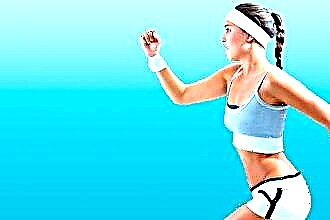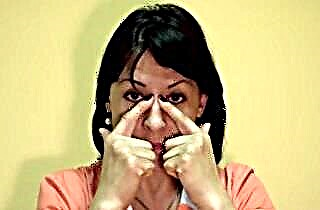For people who often have high blood pressure, it is important to find the optimal physical activity. Fanatical exercise can exacerbate an already serious problem. If we talk about running with hypertension, then it is advisable to alternate it with walking. This will allow you to maintain the tone of the body at the proper level and achieve a decrease in pressure up to 20 mm. mercury column.
Can I run with hypertension?

Physical activity for hypertensive patients is extremely necessary. An inactive lifestyle, even in healthy people, provokes the development of various diseases, and for a person with hypertension, this can be fatal. But here it is important not to overdo it with sports. Physical activity should not lead to excessive overstrain of the body.
Many will agree that sport disciplines, clarifies consciousness, energizes. In addition, it helps to get rid of the accumulated tension, stress, aggression, accumulated adrenaline. The result is good health, mood, and self-confidence. All these are very important components to help fight various ailments.
Physical activity in the presence of hypertension dilates blood vessels, helps to reduce peripheral resistance, increase blood supply to muscle tissues, strengthen arterial and venous vessels. Exercising is really very rewarding. They contribute to the restoration of cholesterol metabolism, disruptions of which lead to an increase in blood pressure.
The choice of physical activity is determined by the attending physician. It is he who will be able to choose exercises that will be as useful as possible for a particular stage of the disease. It is very important that physical activity is combined with taking the necessary medications to stabilize the pressure. Exercises are divided into two main types.
| Exercise type | the effect |
|---|---|
| Isotonic | They increase the load on the limbs, as a result of which the body begins to waste more energy and burn calories. The implementation of such exercises stimulates the work of the lungs, heart muscle, which has a beneficial effect on pressure. |
| Isometric | They develop musculature, increase it over time. As a result, body weight increases, and this in turn contributes to an increase in blood pressure. In this regard, it is highly undesirable for patients with hypertension to lift weights. It is necessary to avoid gymnastic exercises, do not climb a hill with a load. |
Permissible loads for hypertensive patients are represented by the following physical exercises.
- A walk on the bike. For these purposes, you can use an exercise bike or a real bike. Moderate speed, short driving on flat terrain, fresh air have a positive effect on the human body.
- Swimming. This type of physical activity is excellent for hypertensive patients with overweight and joint disease. Swimming strengthens the muscles of the back and arms while minimizing stress on the knees. Such procedures, when immersed in sea water, saturate the body with useful salts and iodine. Scientists have shown that regular swimming three times a week in a moderate mode can lower blood pressure levels.
- Walking. A leisurely walk in the open air will be useful even for those with joint problems. If it is difficult to walk, you can use a support. The starting level will be a daily walk for a distance of 2 kilometers. The distance traveled can be increased every 14 days. The patient's task is to cover a distance of 4 kilometers every day in one hour. At the same time, the heart rate indicators should not increase.
- Physiotherapy. It is aimed at restoring the body, strengthening joints, training certain muscle groups that need rehabilitation.
- Run. Its benefits in hypertension have been proven by numerous medical studies.
 Running perfectly normalizes blood pressure. At the same time, it is able to heal the entire body. Regular exercise with adequate intensity dilates the blood vessels, which reduces the pressure level. In addition to stabilizing the tonometer readings, patients note improvements in the functioning of the stomach and intestinal tract, urinary and reproductive systems. Jogging speeds up the process of cleansing the blood, strengthens the muscles of the legs and brings body weight back to normal. Being outdoors is considered even more beneficial. A treadmill at a sports club will work too, but nothing beats sports in the background.
Running perfectly normalizes blood pressure. At the same time, it is able to heal the entire body. Regular exercise with adequate intensity dilates the blood vessels, which reduces the pressure level. In addition to stabilizing the tonometer readings, patients note improvements in the functioning of the stomach and intestinal tract, urinary and reproductive systems. Jogging speeds up the process of cleansing the blood, strengthens the muscles of the legs and brings body weight back to normal. Being outdoors is considered even more beneficial. A treadmill at a sports club will work too, but nothing beats sports in the background.
How does the pressure change?
The pressure, depending on the load, can rise and fall. This is due to the individual characteristics of each individual organism and the work of the cardiovascular system. Any physical activity accelerates blood flow, increases heart rate, dilates blood vessels. As a result, adrenaline is formed, which is released into the blood, which in turn makes the cardiovascular system work at an accelerated rate. These changes cause a spike in blood pressure.
At the time of running, the heart rate increases and the heart expands. Against this background, there are changes in the pulse and blood pressure. As a rule, the pressure readings increase by an average of 20 mm. mercury column. In some cases, this mark can reach 80 mm. mercury column.
As you run, blood from the heart flows into the arteries, which increases blood pressure. This is absolutely not dangerous for the body of hypertensive patients, since the increased indicators after a short time return to their normal state.
The duration of recovery after physical activity is individual for each patient. Exercise is the most important factor in blood pressure normalization. In addition, it acts as a preventive measure that reduces the risk of diseases of the cardiovascular system. Peripheral vessels expand, as a result of which the work of the heart muscle is facilitated, as well as blood flow in the muscles improves. Since an increase in pressure during physical activity is inevitable, the cardiologist selects the type of load and its duration so that it does not harm a person's health and does not aggravate the degree of arterial hypertension.
For each hypertensive person, physical activity should be selected individually. Experts recommend taking pressure measurements before and after running. If the indicators have reached their norm after 10 minutes, this indicates that the load is selected correctly and will not cause any harm to health. If after 10 minutes. after the end of the run, the indicators remain elevated, it is necessary to consult a cardiologist for additional advice.
Recommendations
Hypertension is an insidious disease in which intense exercise is highly discouraged. Their number must be increased gradually so that the body can adapt painlessly. For young hypertensive patients under 40, it takes at least a month for the body to get used to physical activity. For patients of the older age group, this period extends to 6 months.
For the exercises to be beneficial, they must be done willingly. In this case, a person needs to carefully monitor his health.As soon as the body begins to tolerate stress well, you can safely start running in the fresh air. Exercising in open areas helps to reduce hypoxia in organs and tissues. Before starting training, it is necessary to consult with your doctor on this matter. Even if the doctor approved of jogging, it is important to adhere to some rules.
- Exercise should become a habit. The patient should accustom himself to daily activities at the same time, no matter what the weather is outside.
- The aim of the lesson is not to increase speed, but distance. Hypertensive patients are advised to run only at a slow pace.
- Before the race, you must thoroughly knead the joints and warm up the body.
- It is necessary to develop a specific running system.
 It looks like this: in 1 day - jogging at a slow pace for 15 minutes. After 2 days, the load should be increased by 5 minutes. Ultimately, one session should last 40 minutes, which the patient should run without difficulty. As for the distance that a person must travel, the scheme looks like this: on the first day you need to run 1 kilometer, on the second day - 2 kilometers, on the third - 4 kilometers, then the day of the break, and from day 5 the distance decreases, and you need to run in reverse sequence. This scheme is optimal for the body of hypertensive patients, it is very effective and not at all tiring.
It looks like this: in 1 day - jogging at a slow pace for 15 minutes. After 2 days, the load should be increased by 5 minutes. Ultimately, one session should last 40 minutes, which the patient should run without difficulty. As for the distance that a person must travel, the scheme looks like this: on the first day you need to run 1 kilometer, on the second day - 2 kilometers, on the third - 4 kilometers, then the day of the break, and from day 5 the distance decreases, and you need to run in reverse sequence. This scheme is optimal for the body of hypertensive patients, it is very effective and not at all tiring. - When jogging, it is extremely important to always listen to your well-being. After jogging, your blood pressure and heart rate should return to normal within 10 minutes. If the load is exceeded, a person may feel a headache, a tide of nausea, dizziness, darkening of the eyes, against which even fainting may occur. In the event of such symptoms, the exercise should be stopped immediately and a doctor should be consulted.
It is important to constantly monitor your pulse. Its value should not exceed 220 beats per minute. An increase in heart rate may indicate excessive exercise. Typically, it should recover from exercise within 5 minutes.
After completing the exercise, it is very important to get a good rest. The best position for this is lying on your back with your legs raised above the level of your heart. Being in this position allows the heart to rest from the load imposed on it, helps it recover quickly and is an excellent prevention of myocardial infarction.
It is necessary to run in comfortable clothes and shoes.  Better if these are branded sneakers specifically designed for such tasks. If a person sweats profusely while running, this is a good sign that the body is being cleansed and healed. Water consumption during exercise should be moderate - no more than 0.5 liters. The workout is best done 1-1.5 hours after eating.
Better if these are branded sneakers specifically designed for such tasks. If a person sweats profusely while running, this is a good sign that the body is being cleansed and healed. Water consumption during exercise should be moderate - no more than 0.5 liters. The workout is best done 1-1.5 hours after eating.
As it turned out, running and hypertension are absolutely compatible concepts. Jogging is not recommended only for those patients who are diagnosed with grade 3 hypertension. This group of people is shown performing physical exercises in the form of a breathing gymnast. You can run at any time of the day. The main thing is that it is not too hot or cold outside. For men, the best time to exercise is in the morning. For women, on the other hand, evening is a favorable time for training.
Unfortunately, at the moment, medicine has not yet clarified the causes of such a disease as hypertension. But the indirect factors of an increase in blood pressure, which at any time can provoke a hypertensive crisis, are excess weight, alcohol and smoking abuse, unhealthy diet, and heredity.
If the symptoms of hypertension have already manifested themselves, the person needs to reconsider their habits and lifestyle.
Along with taking medications, it is important for patients to follow a diet, exercise, consume less salt, and introduce as many vegetables and fruits into the diet as possible. Observing the simple recommendations of doctors, eating right and providing adequate physical activity, you can control the level of blood pressure until a ripe old age, enjoy life, remain vigorous and optimistic.

 Running perfectly normalizes blood pressure. At the same time, it is able to heal the entire body. Regular exercise with adequate intensity dilates the blood vessels, which reduces the pressure level. In addition to stabilizing the tonometer readings, patients note improvements in the functioning of the stomach and intestinal tract, urinary and reproductive systems. Jogging speeds up the process of cleansing the blood, strengthens the muscles of the legs and brings body weight back to normal. Being outdoors is considered even more beneficial. A treadmill at a sports club will work too, but nothing beats sports in the background.
Running perfectly normalizes blood pressure. At the same time, it is able to heal the entire body. Regular exercise with adequate intensity dilates the blood vessels, which reduces the pressure level. In addition to stabilizing the tonometer readings, patients note improvements in the functioning of the stomach and intestinal tract, urinary and reproductive systems. Jogging speeds up the process of cleansing the blood, strengthens the muscles of the legs and brings body weight back to normal. Being outdoors is considered even more beneficial. A treadmill at a sports club will work too, but nothing beats sports in the background. It looks like this: in 1 day - jogging at a slow pace for 15 minutes. After 2 days, the load should be increased by 5 minutes. Ultimately, one session should last 40 minutes, which the patient should run without difficulty. As for the distance that a person must travel, the scheme looks like this: on the first day you need to run 1 kilometer, on the second day - 2 kilometers, on the third - 4 kilometers, then the day of the break, and from day 5 the distance decreases, and you need to run in reverse sequence. This scheme is optimal for the body of hypertensive patients, it is very effective and not at all tiring.
It looks like this: in 1 day - jogging at a slow pace for 15 minutes. After 2 days, the load should be increased by 5 minutes. Ultimately, one session should last 40 minutes, which the patient should run without difficulty. As for the distance that a person must travel, the scheme looks like this: on the first day you need to run 1 kilometer, on the second day - 2 kilometers, on the third - 4 kilometers, then the day of the break, and from day 5 the distance decreases, and you need to run in reverse sequence. This scheme is optimal for the body of hypertensive patients, it is very effective and not at all tiring.

